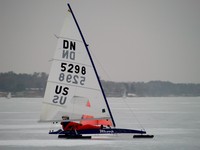How good is good enough?
So I'm screwing around in the shop shimming my DN runners wondering how close the big shots runners are to being parallel. (by big shots I mean those guys that go by you really fast)
If I square my plank up with the wall that is 24' away and clamp my laser level to a runner, mark the wall, clamp it to the other runner, mark the wall and am off by an inch over the 24', that seems like a lot. But if you do a little trapezoidal math it figures out to be about .2 degrees off and it suddenly sounds much better. So obviously zero deviation over a vast distance is ideal, but...really...how much deviation over 24' are you content with?

Reasonable limits of alignment
As another sanity check, I did the following experiment last night:
With the runners clamped tight in the chocks of my Nite plank, upside down supported on saw horses at the plank ends. Top edges of the runners leveled with a spirt level.
Two dial indicators between the runner edges, 16 inches apart and set a zero each. This arrangement gives a pretty sensitive measure of the relative spacing between the runners at those two locations, and you can watch the measurements as they change when you add loads to the system. I then grabbed the front and rear of one runner with my hands, actually just my fingers, and tried to lightly twist it out of alignment. The twisting force I applied is far smaller then the loads a runner would see as it travels over any ice that is less then perfect, maybe over perfect ice as well. I could very easily deflect it to .005 inches out of alignment over that distance, or about 0.1" at 24' in Ensign's setup. This says that even when you precisely align the boat, when you are sailing, things are going to be constantly changing.
Not to say it's a bad idea to strive for perfection!
When I have a chance, I may make some force/deflection measurements.
John Bushey
John Bushey
None....
Think of dragging your runner sideways one inch every 24'.
Anything off the mark can't be good. I use the magnetic laser and verify/reset on the ice with a $5 4X scope as the distances are far greater.
/Adam
Triginometry... I wish I'd paid more attention is school...
I seem to remember one of the hot-shots saying that anything less than 0.030" out of parallel over the length of a 36" runner (probably an 18" flat-section) was unnecessary.
Lets take that as gospel for now...
What's the angle?
sin(theta) = 0.030/18
theta = asin(0.030/18) = 0.095 degrees
By similar triangles, your shop laser setup gives:
0.030/18 = x/(24' * 12"/foot)
x = (0.030/18) * (24*12) = 0.48 inches
So, you should adjust those chocks so the difference is more like 1/2 inch than an inch.
I was just aligning my Nite
I was just aligning my Nite runners in the shop (since there is nothing else to do with them right now) using two dial indicators on aluminum tubes. With these, I can resolve 0.001 inches in each. I have them within .008 inches of equal spacing with the indicators 16 inches apart and parallel to each other. That is about 0.03 degrees. It is tough to make adjustments with the Nite chocks and no runner shims that stay much closer than that. You guys that shim runners, how close can you get them? What various size shim tape is used?
You should be able to check parallelism to better than 0.2 degrees with a simpler setup, maybe even a tape measure since it is about 1/16th inch over 16 inches of runner length.
As an aside, another interesting aspect with this setup is you can zero both gages and then deflect the plank and watch whether the runners stay parallel. I just tried that and with a 0.5 inch plank deflection, the runner alignment changed .005 inches (.02 degrees)
One of the things to watch out for in any alignment setup is where errors can creep in, such as how close your laser axis is to the actual sharp edge, or how repeatable my indicators are. Checking with two different methods may catch some measuring uncertainties.
I know I didn't answer your question, but I'm not one of those guys that goes really fast either....
John Bushey
John Bushey
Guys like world champ Ron
Guys like world champ Ron Sherry use the triangle and string method. A pair of framing squares can be substituted for the triangles. They do it with the plank on the boat and with the boat loaded up to skippers wgt plus about 30 lbs.. The goal is no deviation on the alignment indicators on the triangles. Alignment is most critical in light air and when starting.No one really knows what happens at speed in heavier airs. If you want to be able to sail in lite air you need the best alignment you can get.